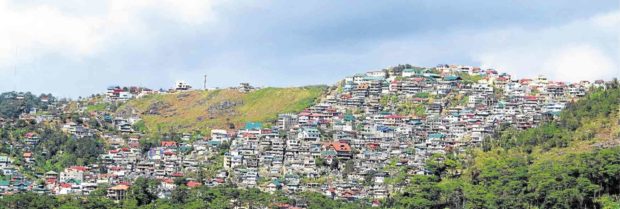Execs’ plea: Exempt Cordillera from building ban on slopes

HILLSIDE LIVING Settlements have been sprouting on Baguio City’s mountainsides since the 1970s, after a proclamation exempted the summer capital from the ban on ownership and development of lots on slopes. —EV ESPIRITU
BAGUIO CITY, Benguet, Philippines — To improve investments and grant land titles to indigenous communities, Cordillera provinces must be exempt from the ban on owning and developing property along mountains and hillsides with 18 percent slopes, according to the region’s top technocrats.
Only Benguet — which includes Baguio — and Cebu are exempted from the coverage of Presidential Decree No. 705 (the Forestry Code), which states that “no land of the public domain 18 percent in slope (or about 10.2 degrees) shall be classified as alienable and disposable, Mila Rimando, Cordillera director of the National Economic and Development Authority (Neda), told a recent meeting of the Regional Development Council (RDC).
The RDC approved the Cordillera spatial development framework covering 2019-2049, which sets as one of its policies the task of securing an exemption of the region’s provinces from PD 705.
“Potential irrigable areas in the region include agriculturally developed lots on 18 percent slopes but these are not in areas classified as hazardous or environmentally critical,” Rimando said.
Benguet was exempted from the prohibition because it has developed areas “planted to agricultural crops using effective erosion control practices or measures like terracing.”
Article continues after this advertisementBaguio has an “established and developed townsite” complete with roads, schools and churches that are not covered by the forestry code.
Article continues after this advertisementUntitled properties
Many towns in Cordillera have untitled properties although 94 percent of the region is covered by ancestral domain or ancestral lands. Only 15 percent (275,769 hectares) of Cordillera land area of 1,829,368 ha is alienable and disposable, according to the Philippine Statistics Authority website.
Forest dwellers have been tolerated by the government due to Section 53 of PD 705 which says the state will not prosecute “‘kaingineros,’ squatters, cultural minorities and other occupants who entered into forest lands before the [law’s] effectivity [in 1975].”
The Cordillera development framework puts together updated maps showing population density, forest cover, growth rate of settlements, existing roads and geological vulnerabilities to “serve as a development planning guide” for local governments, Rimando said.
Growth centers
Neda has been developing two growth centers in Cordillera—the economic cooperation of Baguio and the Benguet towns of La Trinidad, Itogon, Sablan, Tuba and Tublay (BLISTT), and an eastern growth corridor in Kalinga province comprised of Tabuk City and Rizal, Pinukpuk and Tanudan towns.
It also mapped out priority investment areas for coffee development, water, farm tourism and the region’s creative arts, which was inspired by Baguio’s selection as one of the world creative cities by the United Nations Educational, Scientific and Cultural Organization.
The region’s gross regional domestic product in 2018 was 7.3 percent, down from the 12.2 percent growth posted in 2017. —Vincent Cabreza